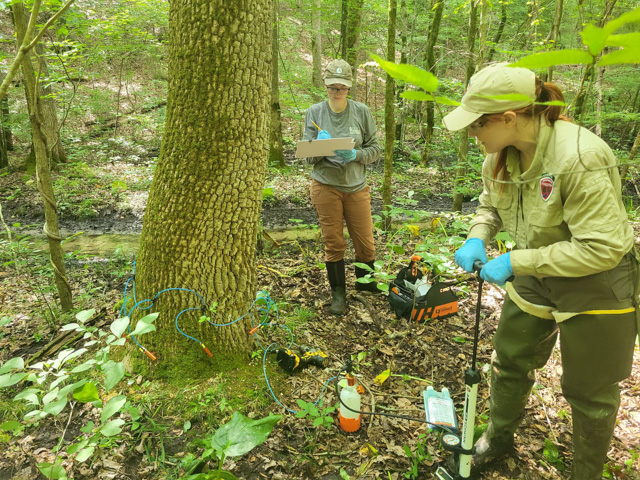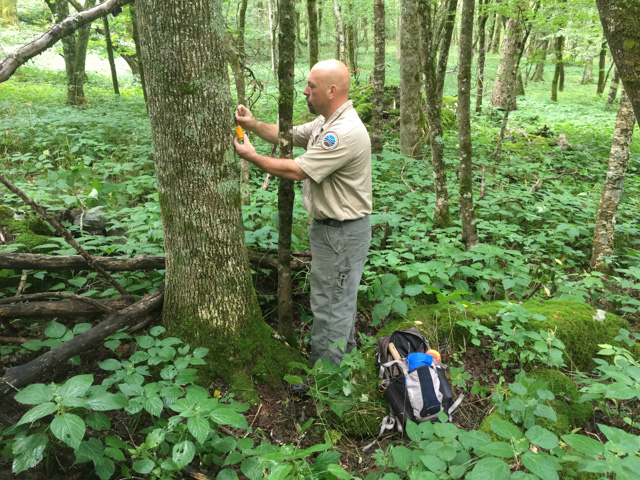
 Department of Conservation and Recreation
Department of Conservation and Recreation
Conserve. Protect. Enjoy.
 Department of Conservation and Recreation
Department of Conservation and Recreation
By Emi EndoPosted August 14, 2023
 A metallic-green invasive insect, the emerald ash borer, has been wiping out ash trees as it has spread through Virginia over the past 15 years. The destructive wood-boring beetle has attacked forests from the mountains to the coast – including stands within Virginia State Parks.
A metallic-green invasive insect, the emerald ash borer, has been wiping out ash trees as it has spread through Virginia over the past 15 years. The destructive wood-boring beetle has attacked forests from the mountains to the coast – including stands within Virginia State Parks.
With assistance and training from the Virginia Department of Forestry, state parks staff are fighting back, armed with insecticides as well as a tiny, parasitoid wasp.
An ash tree native to Virginia has no natural defenses against the emerald ash borer. The larvae bore into and feed on its inner bark and water system, leaving squiggly S-shaped tunnels, or galleries, in their wake. The galleries encircle the inner vascular tissue of the tree, choking it off from water and nutrients and ultimately killing it.
Last year, ecologists in the Virginia Natural Heritage Program at DCR reported that green ash trees at Machicomoco State Park in Gloucester County were infected with emerald ash borer. These trees had been some of the state’s last remaining healthy populations of ash.
In July, a DCR team began treating dozens of green ash in two areas at Machicomoco by injecting an insecticide into the tree’s vascular systems, where it will kill the borer larvae.
Staff also treated infected green ash at four different areas of Chippokes State Park in Surry County.
Katlin DeWitt, a forest health specialist at DOF, has helped to administer the treatments at state parks and assisted DCR staff. “We’re very invested in protecting these trees.” DeWitt said. “We like to work with other state agencies and help save trees on state lands.”
DeWitt said the chemical treatment being used is highly effective for controlling emerald ash borer. “The trees we treated are a lot healthier,” she said. “And we can see the decline on other trees that have not been treated.”
In some cases, the insecticide treatment can be complemented with biological control, or biocontrol, to target the following generation of borers before they can hatch.
One natural enemy of the emerald ash borer is a parasitoid wasp called Oobius agrili. These wasps, approved for release and provided by the USDA Animal and Plant Health Inspection Service, lay their eggs inside the eggs of the emerald ash borer. When the wasp larvae emerge, “Her developing young will kill the emerald ash borer,” DeWitt said.
“We can’t go out and chemically treat every tree in the forest. The little wasps will help fill the gap and provide another level of protection out there for trees we weren’t able to treat.”

White and blue ash trees have been treated for protection against the emerald ash borer for several years now at Southwest Virginia Museum, Natural Tunnel and Grayson Highland state parks.
Jordon Blevins, district resource specialist for the Southwest Region of Virginia State Parks, said that the white ash trees at Southwest Virginia Museum still appeared to be healthy after a few years of treatments.
Saving larger trees in the mountains will help protect the scenic views in addition to preventing damage to the ecosystems, he said.
Nationwide, the emerald ash borer has taken a major toll on forestry and lumber industries, threatening to permanently alter our forest ecosystems.
Of the six species of native ash to Virginia, all are considered endangered, according to DeWitt. “Losing any species that’s native has a whole cascade of effects from an ecosystem perspective,” she said.
Losing ash is even more critical when the species makes up a significant part of a natural community that is rare. A natural community is an assemblage of native plants and animals that occurs repeatedly on the landscape under similar ecological conditions. At Machicomoco and Chippokes, the ash stands are located in the globally rare natural community type called Coastal Plain Calcareous Seepage Swamp Forest.
Erik Molleen, district resource specialist for the Tidewater Region of Virginia State Parks, said that when large ash trees in this natural community die, more sunlight will be let in, promoting the spread of non-native, invasive plant species. “That will open up the canopy and change the herbaceous vegetation. It’s very important that we protect the green ash,” he said. “By protecting that one tree, we’re also protecting the other species in that globally rare ecosystem.”
Categories
Conservation | Native Plants | Natural Heritage | Nature | State Parks

